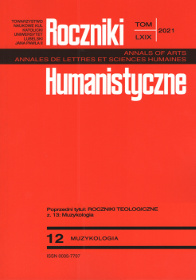Neapolitan Performance Practice in the Instrumental Ensemble Music of the Eighteenth Century
Abstract
When we talk about the Neapolitan school, we usually mean the composers of opera and vocal music, although multicoloured instrumental works were also developing in Naples. Knowledge of these is poor, even among those researching this centre of music. The subject of this article is thus the Neapolitan instrumental work for various types of chamber and orchestral ensembles created over a period of 100 years, starting from the 1690s. Neapolitan performing practices differed from those known in other European centres. Despite practising the same genres (sonata, concerto, symphony), Neapolitan composers displayed different preferences for the scoring of music. Regardless of the genre, they were fond of an ensemble consisting of three or four violins and a bass voice. They avoided use of the viola: less frequently, they used the violin as a solo instrument, but more preferably flutes, a cello, a mandolin and keyboards. It was not the type of scoring of music in Naples that determined the choice of genre (sonata, concerto or symphony), but rather the texture and form. The musical genre also had no influence on whether the piece would be performed by chamber or orchestral ensemble.
References
Bukofzer, Manfred. Muzyka w epoce baroku: Od Monteverdiego do Bacha. Państwowe Wydawnictwo Naukowe, 1970.
Bettarini, Luciano. „Appunti critici sulle ‘Sette Sonate’ per flauto e archi di Alessandro Scarlatti”. Chigiana, t. 25, 1968, ss. 239-246.
Bossa, Renato. „Le sonate a quattro di Giuseppe Antonio Avitrano (1713)”. Miscellanea musicologica, nr 2, 1987, ss. 307-322.
Burney, Charles. A General History of Music from the Earliest Ages to the Present Period. To Which is Prefixed, A Dissertation on the Music of the Ancients, t. 3, Burney, 1789.
Degrada, Francesco. „Le musiche strumentali di Nicolò Porpora.” Chigiana, t. 25, 1968, ss. 99-125.
Dent, Edward J. „The Earliest String Quartets”. The Monthly Musical Record, t. 33, 1903, ss. 202-204.
De Rosa, Carlo Antonio. Memorie dei compositori di musica del regno di Napoli raccolte dal marchese di Villarosa. Stamperia Reale, 1840, s. 142.
Di Benedetto, Renato. „The Sonate a quattro of Angelo Ragazzi (1736)”. International Musicological Society Congress Report (Copenhagen, 1972), ed. Henrik Glahn et al., Edition W. Hansen, 1974, ss. 356-365.
Evelyn, John. „Diary”. The Diary of John Evelyn, ed. William Bray, t. 2, M. Walter Dunne, 1901.
Fertonani, Cesare. „Musica strumentale a Napoli nel Settecento”. Storia della musica e dello spettacolo a Napoli: Il Settecento, red. Francesco Cotticelli, Paologiovanni Maione, Edizioni Turchini, 2009, ss. 925-963.
Gjerdingen, Robert. Music in the Galant Style. Oxford UP, 2007.
Halton, Rosalind. „«Senza cimbalo al tavolino»: Alessandro Scarlatti and his 4 Sonate a quattro”. Studi musicali, Nuova serie, t. 6, nr 1, 2015, ss. 97-130.
Hill, John Walter. Baroque Music: Music in Western Europe, 1580-1750. W.W. Norton & Company, 2005.
Hutchings, Artur. The Baroque Concerto. Faber and Faber, 1959.
Lattanzi, Alessandro. „Il repertorio napoletano di concerti per strumenti a fiato. Materiali per una ricognizione preliminare”. Studi Pergolesiani, nr 10, 2015, ss. 125-158.
Maunder, Richard. The Scoring of Baroque Concertos. The Boydell Press, 2004.
McVeigh, Simon, i Jehoash Hirshberg. The Italian Solo Concerto, 1700–1760: Rhetorical Strategies and Style History. The Boydell Press, 2004.
Olivieri, Guido. „Musica strumentale a Napoli nell’età di Pergolesi: Le sonate per tre violini e basso”. Studi Pergolesiani, nr 4, 2000, ss. 193-207.
Olivieri, Guido. „Tra Napoli e Vienna: Musicisti e organici strumentali nel viceregno austriaco (1701–1736)”. Analecta musicologica, t. 32, 2002, ss. 161-182.
Olivieri, Guido. The „Fiery Genius”: The Contribution of Neapolitan Virtuosi to the Spread of the String Sonata (1684-1736). UMI, 2005, s. 221.
Olivieri, Guido. „Cello Playing and Teaching in Eighteenth-Century Naples: F. P. Supriani’s Principij da imparare a suonare il violoncello”. Performance Practice: Issues and Approaches, ed. Timothy D. Watkins, Steglein Publishing, 2009, ss. 109-136.
Sanguinetti, Giorgio. The Art of Partimento: History, Theory, and Practice. Oxford UP, 2012.
Sigismondo, Giuseppe. Descrizione della cittá di Napoli e suoi borghi, t. 3, Fratelli Terres, 1789, s. 202.
Talbot, Michael, i Rosalind Halton. „«Choice Things of Value»: The Mysterious Genesis and Character of the VI Concertos in Seven Parts Attributed to Alessandro Scarlatti”. Eighteenth-Century Music, t. 12, nr 1, 2015, ss. 15-16.
Timpe, Christoph. „Violinmusik in Neapel in der ersten Hälfte des 18. Jahrhunderts”. Analecta musicologica, nr 32, 2002, ss. 183-208.
Van Tour, Peter. Counterpoint and Partimento: Methods of Teaching Composition in Late Eighteenth-Century Naples. Upsala U, 2015.
Wilk, Piotr. „The Concerto in the Oeuvre of Nicola Fiorenza”. Ad Parnassum. A Journal of Eighteenth- and Nineteenth-Century Instrumental Music, t. 17, nr 33, 2019, ss. 1-43.
Wilk, Piotr. „«New» Cello Concertos by Nicola Porpora”. Musica Iagellonica, t. 11, 2020, ss. 5-36.
Copyright (c) 2021 Roczniki Humanistyczne

This work is licensed under a Creative Commons Attribution-NonCommercial-NoDerivatives 4.0 International License.





